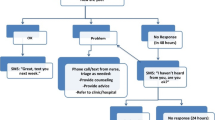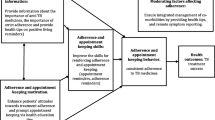Abstract
This two-phase pilot study aimed to design, pilot, and refine an automated interactive voice response (IVR) intervention to support antiretroviral adherence for people living with HIV (PLH), in Kolkata, India. Mixed-methods formative research included a community advisory board for IVR message development, 1-month pre-post pilot, post-pilot focus groups, and further message development. Two IVR calls are made daily, timed to patients’ dosing schedules, with brief messages (<1-min) on strategies for self-management of three domains: medical (adherence, symptoms, co-infections), mental health (social support, stress, positive cognitions), and nutrition and hygiene (per PLH preferences). Three ART appointment reminders are also sent each month. One-month pilot results (n = 46, 80 % women, 60 % sex workers) found significant increases in self-reported ART adherence, both within past three days (p = 0.05) and time since missed last dose (p = 0.015). Depression was common. Messaging content and assessment domains were expanded for testing in a randomized trial currently underway.

Similar content being viewed by others
References
Agyapong VIO, Ahern S, McLoughlin DM, Farren CK. Supportive text messaging for depression and comorbid alcohol use disorder: single-blind randomised trial. J Affect Disord. 2012;141:168–76. doi:10.1016/j.jad.2012.02.040.
Bangsberg DR. Less than 95 % adherence to nonnucleoside reverse-transcriptase inhibitor therapy can lead to viral suppression. Clin Infect Dis. 2006;43(7):939–41.
Bush K, Kivlahan DR, McDonell MB, Fihn SD, Bradley KA. The AUDIT alcohol consumption questions (AUDIT-C): an effective brief screening test for problem drinking. Arch Intern Med. 1998;158(16):1789–95 sd.
Chesney MA, Ickovics JR, Chambers DB, Gifford AL, Neidig J, Zwickl B, Wu AW. Self-reported adherence to antiretroviral medications among participants in HIV clinical trials: the AACTG adherence instruments. Patient Care Committee & Adherence Working Group of the Outcomes Committee of the Adult AIDS Clinical Trials Group (AACTG). AIDS Care. 2000;12(3):255–66.
Coomes CM, Lewis MA, Uhrig JD, Furberg RD, Harris JL, Bann CM. Beyond reminders: a conceptual framework for using short message service to promote prevention and improve healthcare quality and clinical outcomes for people living with HIV. AIDS Care. 2012;24(3):348–57 Epub 2011 Sep 21.
Crepaz N, Tungol-Ashmon MV, Higa DH, Vosburgh W, Mullins MM, Barham T,… Lyles CM. A systematic review of interventions for reducing HIV risk behaviors among people living with HIV in the United States, 1988–2012. AIDS. 2014;28(5): 633–56.
Finitsis DJ, Pellowski JA, Johnson BT. Text message intervention designs to promote adherence to antiretroviral therapy (ART): a meta-analysis of randomized controlled trials. PLoS One. 2014;9(2):e88166.
Fisher JD, Fisher WA, Amico KR, Harman JJ. An information-motivation-behavioral skills model of adherence to antiretroviral therapy. Health Psychol. 2006;25(4):462.
Garrett JJ. Elements of user experience, the: user-centered design for the web and beyond. London: Pearson Education; 2010.
Genberg BL, Wilson IB, Bangsberg DR, Arnsten J, Goggin K, Remien RH,… MACH14 Investigators. Patterns of antiretroviral therapy adherence and impact on HIV RNA among patients in North America. AIDS (London, England). 2012;26(11):1415.
Gentry S, van Velthoven MH, Tudor Car L, Car J. Telephone delivered interventions for reducing morbidity and mortality in people with HIV infection. Cochrane Database System Rev. 2013;5:CD009189.
Hardy H, Kumar V, Doros G, Farmer E, Drainoni ML, Rybin D,… Skolnik PR. Randomized controlled trial of a personalized cellular phone reminder system to enhance adherence to antiretroviral therapy. AIDS Patient Care St. 2011;25(3):153–61.
Herrmann C. International experiences with the Hospital Anxiety and Depression Scale—a review of validation data and clinical results. J Psychosom Res. 1997;42(1):17–41.
Johnson MO, Charlebois E, Morin SF, Remien RH, Chesney MA, The NIMH Healthy Living Project Team. Effects of a behavioral intervention on antiretroviral medication adherence among people living with HIV: The Healthy Living Project randomized controlled study. J Acquir Immune Defic Syndr. 2007;46(5):574–80.
Joshi A, Rane M, Roy D, Emmadi N, Srinivasan P, Kumarasamy N,… Rutten R. Supporting treatment of people living with HIV/AIDS in resource limited settings with IVRs. In Proceedings of the 32nd annual ACM conference on Human factors in computing systems. 2014; pp. 1595–1604. ACM.
Kalichman SC, Kalichman MO, Cherry C, Swetzes C, Amaral CM, White D, et al. Brief behavioural self-regulation counselling for HIV treatment adherence delivered by cell phone: an initial test of concept trial. AIDS Patient Care and STDs. 2011;25(5):303–10.
Langebeek N, Gisolf EH, Reiss P, Vervoort SC, Thóra B, Richter C,… Nieuwkerk PT. Predictors and correlates of adherence to combination antiretroviral therapy (cART) for chronic HIV infection: a meta-analysis. BMC Med. 2014;12(1):142.
Lester RT, Ritvo P, Mills EJ, Kariri A, Karanja S, Chung MH,… Plummer FA. Effects of a mobile phone short message service on antiretroviral treatment adherence in Kenya (WelTel Kenya1): a randomised trial. The Lancet. 2010;376(9755):1838–1845.
Malta M, Strathdee SA, Magnanini MM, Bastos FI. Adherence to antiretroviral therapy for human immunodeficiency virus/acquired immune deficiency syndrome among drug users: a systematic review. Addiction. 2008;103(8):1242–57.
Mbuagbaw L, Thabane L, Ongolo-Zogo P, Lester RT, Mills E J, Smieja M,… Kouanfack C. The Cameroon mobile phone SMS (CAMPS) trial: a randomized trial of text messaging versus usual care for adherence to antiretroviral therapy. PLoS One. 2012;7(12):e46909.
Mbuagbaw L, van der Kop ML, Lester RT, Thirumurthy H, Pop-Eleches C, Ye C,… Thabane L. Mobile phone text messages for improving adherence to antiretroviral therapy (ART): an individual patient data meta-analysis of randomised trials. BMJ Open. 2013;3(12):e003950.
Miles MB, Huberman AM. An expanded sourcebook: qualitative data analysis. 2nd ed. Thousand Oaks: Sage; 1994.
Mills EJ, Nachega JB, Buchan I, Orbinski J, Attaran A, Singh S,… Bangsberg DR. Adherence to antiretroviral therapy in sub-Saharan Africa and North America: a meta-analysis. JAMA. 2006;296(6):679–690
Mhaskar R, Alandikar V, Emmanuel P, Djulbegovic B, Patel S, Patel A,… Kumar A. Adherence to antiretroviral therapy in India: a systematic review and meta-analysis. Indian J Community Med. 2013;38(2):74.
mobiForge (2014). Global mobile statistics 2014 Part A: mobile subscribers; handset market share; mobile operators. May 16, 2014. http://mobiforge.com/research-analysis/global-mobile-statistics-2014-part-a-mobile-subscribers-handset-market-share-mobile-operators?mT.
Mumford DB, Tareen IAK, Bajwa MAZ, Bhatti MR, Karim R. The translation and evaluation of an Urdu version of the Hospital Anxiety and Depression Scale. Acta Psychiatr Scand. 1991;83:81–5. doi:10.1111/j.1600-0447.1991.tb07370.x.
Nachega JB, Stein DM, Lehman DA, Hlatshwayo D, Mothopeng R, Chaisson RE, Karstaedt AS. Adherence to antiretroviral therapy in HIV-infected adults in Soweto, South Africa. AIDS Res Hum Retroviruses. 2004;20(10):1053–6.
Ortego C, Huedo-Medina TB, Llorca J, Sevilla L, Santos P, Rodríguez E,… Vejo J. Adherence to highly active antiretroviral therapy (HAART): a meta-analysis. AIDS Behav. 2011;15(7): 1381–1396.
Parienti JJ, Das-Douglas M, Massari V, Guzman D, Deeks SG, Verdon R, Bangsberg DR. Not all missed doses are the same: sustained NNRTI treatment interruptions predict HIV rebound at low-to-moderate adherence levels. PLoS One. 2008;3(7):e2783.
Pop-Eleches C, Thirumurthy H, Habyarimana JP, Zivin JG, Goldstein MP, De Walque D,… Bangsberg DR. Mobile phone technologies improve adherence to antiretroviral treatment in a resource-limited setting: a randomized controlled trial of text message reminders. AIDS (London, England). 2011;25(6):825.
Reynolds NR, Testa MA, Su M, Chesney MA, Neidig JF, Frank I, et al. Telephone support to improve antiretroviral medications adherence: a multisite randomized controlled trial. J Acquir Immune Defic Syndr. 2008;47(1):62–8.
Rodrigues R, Shet A, Antony J, Sidney K, Arumugam K, Krishnamurthy S,… DeCosta A. Supporting adherence to antiretroviral therapy with mobile phone reminders: results from a cohort in South India. PloS One. 2012;7(8):e40723.
Rotheram-Borus MJ, Swendeman D, Chorpita BF. Disruptive innovations for designing and diffusing evidence-based interventions. Am Psychol. 2012;67(6):463–76.
Rotheram-Borus MJ, Swendeman D, Comulada WS, Weiss RE, Lee M, Lightfoot M. Prevention for substance-using HIV-positive young people: telephone and in-person delivery. J Acquir Immune Defic Syndr. 2004;37(Suppl 2):S68.
Rotheram-Borus MJ, Swendeman D, Flannery D, Rice E, Adamson DM, Ingram B. Common factors in effective HIV prevention programs. AIDS Behav. 2009;13(3):399–408.
Ryan RM, Deci EL. Self-determination theory and the facilitation of intrinsic motivation, social development, and well-being. Am Psychol. 2000;55(1):68.
Rueda S, Park-Wyllie LY, Bayoumi AM, Tynan AM, Antoniou TA, Rourke SB, Glazier RH. Patient support and education for promoting adherence to highly active antiretroviral therapy for HIV/AIDS. Cochrane Database Syst Rev. 2006;3(3):CD001442.
Saberi P, Johnson MO. Technology-based self-care methods of improving antiretroviral adherence: a systematic review. PLoS One. 2011;6(11):e27533.
SAS Institute Inc, Cary, N.C: SAS Institute Inc.
Shilton, Katie, et al. “Participatory design of sensing networks: strengths and challenges.” Proceedings of the Tenth Anniversary Conference on Participatory Design 2008. Indiana University, 2008.
Simoni JM, Amico KR, Smith L, Nelson K. Antiretroviral adherence interventions: translating research findings to the real world clinic. Curr HIV/AIDS Rep. 2010;7(1):44–51.
Simoni JM, Pearson CR, Pantalone DW, Marks G, Crepaz N. Efficacy of interventions in improving highly active antiretroviral therapy adherence and HIV-1 RNA viral load: a meta-analytic review of randomized controlled trials. J Acquir Immune Defic Syndr. 2006;43(01):S23.
Snaith RP. The hospital anxiety and depression scale. Health Qual Life Outcomes. 2003;1(1):29.
Swendeman D, Ingram BL, Rotheram-Borus MJ. Common elements in self-management of HIV and other chronic illnesses: an integrative framework. AIDS Care. 2009;21(10):1321–34.
Telecom Regulatory Authority of India (2014). Annual Report 2012–2013. Accessed online at: http://www.trai.gov.in/WriteReadData/UserFiles/Documents/AnuualReports/TRAI-English-Annual-Report-10032014.pdf.
Thomas BC, Devi N, Sarita GP, Rita K, Ramdas K, Hussain BM, Rejnish R, Pandey M. Reliability & validity of the Malayalam hospital anxiety & depression scale (HADS) in cancer patients. Indian J Med Res. 2005;122:395–9.
UNAIDS. Technical report, India—HIV estimates 2012. Retrieved from http://www.unaids.org/en/media/unaids/contentassets/documents/data-and-analysis/tools/spectrum/India2012report.pdf.
Vervloet M, Linn AJ, van Weert JC, De Bakker DH, Bouvy ML, Van Dijk L. The effectiveness of interventions using electronic reminders to improve adherence to chronic medication: a systematic review of the literature. J Am Med Inform Assoc. 2012;19(5):696–704.
Wise J, Operario D. Use of electronic reminder devices to improve adherence to antiretroviral therapy: a systematic review. AIDS Patient Care STDs. 2008;22(6):495–504.
Whittaker R, Merry S, Stasiak K, McDowell H, Doherty I, Shepherd M, … Rodgers A. MEMO—A mobile phone depression prevention intervention for adolescents: development process and post-program findings on acceptability from a randomized controlled trial. J Med Internet Res. 2012;14(1):e13. doi:10.2196/jmir.1857.
Acknowledgments
This research was supported by collaborative funding from the Indian Council of Medical Research (ICMR) grant INDO-US/86/9/20 1O-ECD-II and the U.S. National Institutes of Health grant R21AI094666. Additional support was provided by the Center for HIV Identification, Prevention, and Treatment Services (CHIPTS, NIMH Grant MH58107) and NIH grants 5P30AI028697 and UL1TR000124. The content is solely the responsibility of the authors and does not necessarily represent the official views of the NIH or ICMR. We are also grateful to the participants who participated in this study.
Author information
Authors and Affiliations
Corresponding author
Rights and permissions
About this article
Cite this article
Swendeman, D., Jana, S., Ray, P. et al. Development and Pilot Testing of Daily Interactive Voice Response (IVR) Calls to Support Antiretroviral Adherence in India: A Mixed-Methods Pilot Study. AIDS Behav 19 (Suppl 2), 142–155 (2015). https://doi.org/10.1007/s10461-014-0983-9
Published:
Issue Date:
DOI: https://doi.org/10.1007/s10461-014-0983-9




